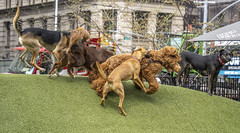The earliest studio photography made use of painters lighting techniques to create photographic portraits. The primary source of light for painters was a large window or skylight facing north, usually above and to one side of the subject.
These techniques were adapted by early photographers from about the middle of the 19th century.
Photography’s major disadvantage compared to portrait painting at this time was that is was only possible to create black and white images.
Hand colouring was popular but never really looked convincing. However it lingered until well into the 1950s due to the cost of colour film and processing – and is sometimes used for stylistic reasons today (In fact you can do such things in Photoshop with old b/w shots).
Artificial lighting
Flash powder was the first means of artificially illuminating photography sufficiently brightly to freeze the action. However it was messy and not very safe so as electricity and the vacuum tungsten light became available this was gradually adopted for studio photography.
Advances in camera lenses and the development of faster film speeds and better lighting meant that studio photography became easier to achieve. Glass plates were replaced by celluloid film in the 30s and the quality became better and better and the ISO increased progressively over the next 20 years. To give an idea of the ultimate quality of 35mm film remember that what you see filling a cinema screen is a projection of a 35mm frame. It is only now that digital cameras are achieving similar quality levels.
Typical studio set up of the 40s, with large “hot lights” and cumbersome plate camera.
Studio flashes became available in the 40s but were extremely expensive and dangerous (they could explode). By the 60s they were in common use in professional studios, but small time portrait photographers would of still been using tungsten lights (or hot lights).
It was until as late as the late 70s that flashes (sometimes called strobes) were affordable by the small studio.
In the last ten years digital studio photography has come of age. Although in some instances film is still used.
Methodology
The difference separating studio photography from all other types is that the photographer has to create EVERYTHING eventually appearing in front of the camera. Usually your starting point is an empty studio.
Even if you have a subject (person, object etc) what environment or context do you want to put them in? This will depend on what you want to communicate – it could be a simple background or a complex ‘set’.
You will need to learn to pre-visualise and create an environment for the shots – this usually means sketching studio plans. You may need to think about props, wardrobe, make up but most importantly light.
During this module I will help you with some of this but you will need to be creative and solve some of the above problems yourselves.
Genres
There is a range of genres within studio photography that we need to examine. These are:
- Advertising Illustration (eg food, product, corporate, architecture, film library etc)
- Still Life
- Portraiture
- Fashion (which is really a sub set of advertising)
- Fine ArtWhat they have in common is communication – this could be the style, power, function, merits and advantages – or the lifestyle it fits with.For the portrait photographer it may be about glamorising the ordinary.



